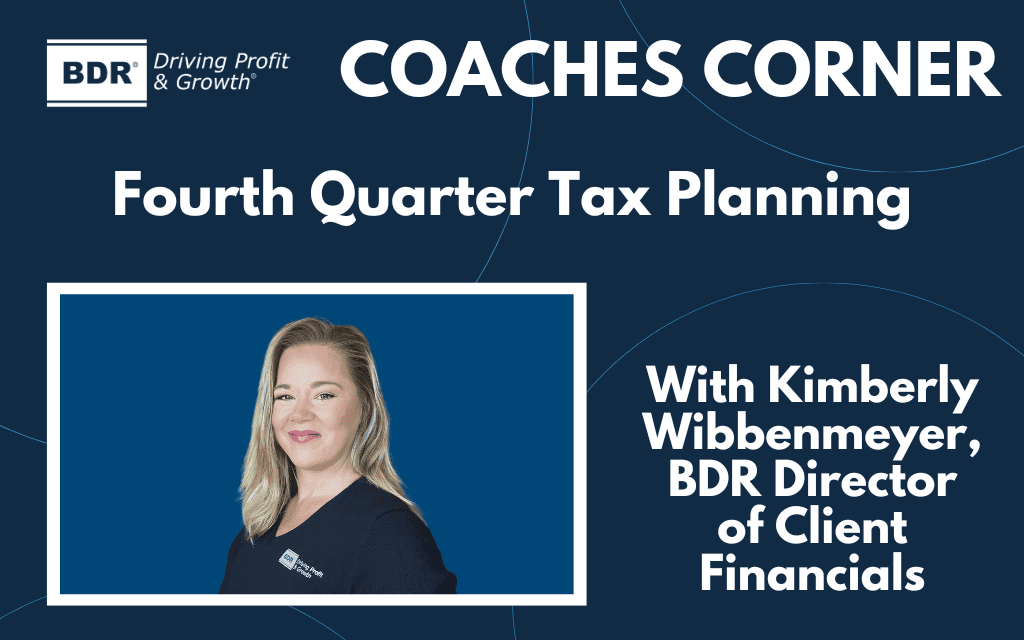Fourth Quarter Tax Planning

KIMBERLY WIBBENMEYER
BDR Director of Client Financials
With the seasonal changes in your business, now is the perfect time to start planning for year-end taxes. Some of you have already started this process, while others may be asking, “What is Tax Planning?” Tax planning, in the simplest of terms, is a review of your financial affairs to reduce or minimize your tax burden.
It is important to start tax planning prior to the end of your fiscal year, either in the late third quarter or early fourth quarter. The accuracy of your financial statements plays a key role. For example, the Profit & Loss Statement, along with the balance sheet, should be reviewed for tax planning as the balance sheet tells us the health of the company. All balance sheet accounts should be reconciled to actual statements monthly, but every quarter at minimum. At the end of the third quarter, schedule a time to meet with your CPA. While all balance sheet accounts should be reconciled, below are the specific areas that must be reconciled.
Accounts Receivable
Review the A/R Aging Summary for any account balances over 90 days past due:
- Discuss the collection policy and procedure with your team.
- Where does each account stand for any account balances over 90 days?
- If you have a debt that is uncollectable, follow your Bad Debt Write-Off procedure. Your A/R Aging Summary should include only balances that are collectible.
Fixed Asset Review
Your fixed asset schedule is the complete listing of all fixed assets purchased by your business:
- Pull your most current asset schedule with depreciation. Request a copy from your CPA if necessary. Your fixed asset schedule should balance with your fixed asset accounts.
- Review the fixed asset schedule for accuracy.
- For any currently fixed asset purchases, gather copies of the invoice or sales receipt to give to your CPA.
- Make note of any assets that have been removed or disposed of.
- Accumulated depreciation should also be listed and match the balance sheet plus any depreciation booked in the current year.
Inventory
A physical inventory count must be completed at year-end at a minimum. BDR recommends a quarterly physical inventory. Incorrect inventory balances mean that the Cost of Goods is stated incorrectly. If you are not already doing so, move to quarterly counts starting next fiscal year to adjust your inventory more frequently.
Accounts Payable
Reconcile your A/P Summary to vendor statements:
- Reconcile this report monthly if you are not doing so.
- Review the A/P Aging Summary balance against vendor statement totals for the end of the month. If you don’t have a statement, compare the summary to any unpaid Accounts Payable invoice.
- If vendor balances are over or understated, then your Profit & Loss is not accurate.
Credit Card Accounts
Credit card accounts should be reconciled monthly to the statement. Verify the last reconciliation. Make it a priority to monitor unauthorized charges before the statement is reconciled.
Prepaid Maintenance
This account should be reconciled monthly. Review open balances against your open maintenance agreement list to verify both amounts match.
Customer Deposits
This account should be reconciled monthly. Review open balances per customer against the job log to verify if the job is still open or if work is incomplete.
Notes Payable
All notes payable balances should be reconciled back to a lender statement. Each monthly payment is split between principal and interest. The principal portion should be posted to the appropriate notes payable account monthly, and the interest portion should be posted to interest expense in overhead.
- Write off Bad Debt in your Accounts/Receivable.
- Fixed asset purchases increase your depreciation.
- Inventory adjustments will either increase or decrease your Cost of Goods sold accounts.
- Prepaid maintenance and customer deposits could affect the revenue you are reporting for the year.
One final thought on tax planning: it is a great time to review your fixed assets. This information should be used to determine the capital expenditure needed for your Profit Launch Business Plan. Keep in mind that large capital purchases at year-end are not always a wise decision. Do not liquidate your cash just to reduce your tax burden. Those cash reserves may be needed to see you through your shoulder season. Work with your head coach to understand your working capital so you can make informed decisions about capital expenditures.
If you would like more information about BDR workshops related to accounting and finances, check out the classes below!
- Accounting & Office Management
- How to Read Your Profit & Loss
- How to Read Your Balance Sheet
- QuickBooks for Contractors
About the Author
Kimberly Wibbenmeyer‘s expertise includes auditing or restructuring accounting software, process flow review, and streamlining processes and procedures. Throughout her professional career, she has worked in several different industries, from healthcare to manufacturing and eventually to HVAC, providing a diverse background in accounting practices.

